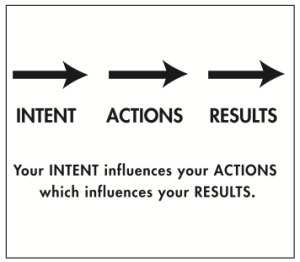Intention
by Al Coleman
 When we speak of the Real vs The Assumed Objective in exercise, we speak of both its theoretical and practical implications. The theoretical side is necessary in order to develop and refine all of the components of the protocol. The practical side speaks mainly to the subject’s mental intention.
When we speak of the Real vs The Assumed Objective in exercise, we speak of both its theoretical and practical implications. The theoretical side is necessary in order to develop and refine all of the components of the protocol. The practical side speaks mainly to the subject’s mental intention.
A subject’s intention when commencing an exercise is the single most important consideration in exercise. The subject’s expression of the protocol is born from his/hers intention. A subject who has comprehended the Real Objective intellectually and is still reservedly carrying it out has an exercise expression that stands out in stark contrast to the subject who intellectually and viscerally comprehends it. In my 13 years of practicing this protocol, the former out weigh the latter in droves. In fact, it is quite rare to come across the latter.
To those who think you might fit into the first category, don’t worry because the fix is easy as I shall explain to you in the following experiment in intention.
Pick an exercise and choose a load that would be considered too light for you. Pretend that you are an instructor who must enter the exercise as a last resort and demonstrate its performance for a subject who just doesn’t seem to be catching on. You are extremely attentive to ensure that force is built so gradually that weight stack barely cracks. From there you are careful not to speed up and to continue to perform what feels like a 10 second positive. You hide the upper turnaround and are careful to perform the negative in a uniform fashion. You start and finish another cycle so that you can show a proper lower turnaround. Surmising that this is sufficient for the subject to witness, you stop. Take note of how that demonstration felt. Did it feel easy? It theoretically should have, correct? After all the load was extremely light relative to what typically challenges you.
 I’m going to now tell you what you more than likely experienced with that sub maximal demonstration. You probably were shocked by how hard those two repetitions felt. While they weren’t incredibly taxing, they made your musculature uncomfortable to a surprising degree. Your limbs probably quivered an embarrassing amount during the performance and they continued to do so after you finished. What’s this all about?
I’m going to now tell you what you more than likely experienced with that sub maximal demonstration. You probably were shocked by how hard those two repetitions felt. While they weren’t incredibly taxing, they made your musculature uncomfortable to a surprising degree. Your limbs probably quivered an embarrassing amount during the performance and they continued to do so after you finished. What’s this all about?
Before I answer that question, allow me to quickly reveal the unfortunate fact that this is most likely the manner in which all of the practitioners who in the past have professed lackluster results with this protocol have performed it. Again, there was no intellectual/visceral comprehension of the intention.
The things that occur as you perform the above demonstration occur because you enter into it with no real intention to fatigue yourself rapidly. You haven’t primed the nervous system to carry out what you know is the intellectual objective. You were performing a demonstration and as such were carrying it out in a restrained fashion. As previously mentioned, it is revealing that this demonstration is the manner in which most people actually carry out their training!
Although it is difficult to wrap one’s head around, it must be remembered that the comes first with the protocol being built around that. You look to the protocol as a system of standardization and to make sure that inroad isn’t escaping, but you must first intend to inroad to drive the system. To check this, carry out the described demonstration but instead intend right from the first second you engage the movement arm that you will make sure that you are trying to dump all of your reserves without delay. Don’t concern yourself with the fact the resistance is too light. Concern yourself with the things that could be constraining. Be on the lookout for any minor lateral shifts of any body part. Consciously try to produce force in a pure linear fashion (compound movements) or a pure arc like fashion (rotary movements). If you produce force correctly, the excessive vibration you encounter will be minimized (exceptions withstanding). Your movement will smooth out, you’ll feel a simultaneous relaxation of the extraneous structures, and your breathing will free up.
comes first with the protocol being built around that. You look to the protocol as a system of standardization and to make sure that inroad isn’t escaping, but you must first intend to inroad to drive the system. To check this, carry out the described demonstration but instead intend right from the first second you engage the movement arm that you will make sure that you are trying to dump all of your reserves without delay. Don’t concern yourself with the fact the resistance is too light. Concern yourself with the things that could be constraining. Be on the lookout for any minor lateral shifts of any body part. Consciously try to produce force in a pure linear fashion (compound movements) or a pure arc like fashion (rotary movements). If you produce force correctly, the excessive vibration you encounter will be minimized (exceptions withstanding). Your movement will smooth out, you’ll feel a simultaneous relaxation of the extraneous structures, and your breathing will free up.
You obviously won’t be going to failure with this experiment, but it will teach you a great deal about the subtle nature of what the success of this protocol hinges on. If you are an instructor, you may have a subject that is numerically doing the protocol correctly, but something just seems “off”. This subtle distinction in intention is the hair breadths deviation between “off” and “on”.
Please test this out.